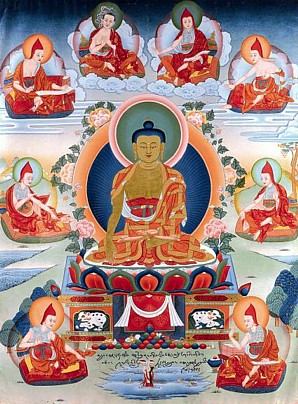Tengyur: Difference between revisions
No edit summary |
mNo edit summary |
||
| (17 intermediate revisions by 6 users not shown) | |||
| Line 1: | Line 1: | ||
'''Tengyur''' – the commentaries on the teachings of the Buddha. The Tibetan Buddhist | [[Image:Buddha and 6 Ornaments 2 Supreme.jpg|frame|[[Buddha]] with the [[Six Ornaments and Two Supreme Ones]]]] | ||
'''Tengyur''' (Tib. བསྟན་འགྱུར་, [[Wyl.]] ''bstan 'gyur'') – the commentaries on the teachings of the [[Buddha]]. The Tibetan [[Buddhist Canon]] is divided into the [[Word of the Buddha|actual words]] of the Buddha contained in the [[Kangyur]], and the treatises composed by the learned and accomplished masters of India, which are contained in the Tengyur. | |||
Ringu Tulku Rinpoche has said: | [[Ringu Tulku Rinpoche]] has said: | ||
All the teachings in Buddhism are divided into two types: the direct teaching of the Buddha and the commentaries. The teachings that come directly from the Buddha are called [[sutra]]s in Sanskrit and [[Kangyur]] in Tibetan. You might call them the scriptural or canonical teachings. The commentaries are called [[shastra]]s in Sanskrit and '' | |||
:"All the teachings in Buddhism are divided into two types: the direct teaching of the Buddha and the commentaries. The teachings that come directly from the Buddha are called [[sutra]]s in Sanskrit and [[Kangyur]] in Tibetan. You might call them the scriptural or canonical teachings. The commentaries are called [[shastra]]s in Sanskrit and ''tenchö'' in Tibetan. In Tibetan, this Kangyur is 108 volumes, and the Tengyur, the translation of the commentaries that come from India, is 228 volumes. The commentaries written later on by Tibetans and others can also be called ''tenchö''."<ref>Source needed.</ref> | |||
==Major Editions== | |||
In total there are currently five known Tengyur editions, all of which are printed xylograph collections. Stanley David claims that there is much greater uniformity among Tengyur editions than those of the Kangyur and thus he divides them into two groups:<ref>Stanley, David Phillip. Tibetan Buddhist Canon. Tibetan and Himalayan Digital Library (THL), 2005. http://www.thlib.org/encyclopedias/literary/canons/index.php#!essay=/stanley/tibcanons/s/b2 </ref> | |||
'''Group A:''' | |||
*Peking Tengyur (''pe cin'') | |||
*[[Golden Tengyur]] (''gser bris ma'') | |||
*[[Narthang Tengyur]] (''snar thang'') | |||
'''Group B:''' | |||
*[[Choné Tengyur]] (''co ne'') | |||
*[[Dergé Tengyur]] (''sde dge'') | |||
In addition, there is the Pedurma (''dpe bsdur ma'') edition, which is a comparative edition, recently created, based the Derge collection. | |||
==Notes== | |||
<small><references/></small> | |||
==External Links== | |||
*[http://www.aibs.columbia.edu/tanjur.shtml Description at the American Institute of Buddhist Studies] | |||
*[http://www.thlib.org/encyclopedias/literary/canons/index.php#!essay=/stanley/tibcanons/s/b23 Stanley, David Phillip. Tibetan Buddhist Canon] | |||
*{{84000|https://read.84000.co/section/O1JC7630.html|English Catalogue of the Dergé Tengyur}} | |||
[[Category:Canon]] | |||
[[Category:Tengyur| ]] | |||
[[Category:Texts]] | |||
[[Category:Key Terms]] | |||
Latest revision as of 08:43, 14 September 2023

Tengyur (Tib. བསྟན་འགྱུར་, Wyl. bstan 'gyur) – the commentaries on the teachings of the Buddha. The Tibetan Buddhist Canon is divided into the actual words of the Buddha contained in the Kangyur, and the treatises composed by the learned and accomplished masters of India, which are contained in the Tengyur.
Ringu Tulku Rinpoche has said:
- "All the teachings in Buddhism are divided into two types: the direct teaching of the Buddha and the commentaries. The teachings that come directly from the Buddha are called sutras in Sanskrit and Kangyur in Tibetan. You might call them the scriptural or canonical teachings. The commentaries are called shastras in Sanskrit and tenchö in Tibetan. In Tibetan, this Kangyur is 108 volumes, and the Tengyur, the translation of the commentaries that come from India, is 228 volumes. The commentaries written later on by Tibetans and others can also be called tenchö."[1]
Major Editions
In total there are currently five known Tengyur editions, all of which are printed xylograph collections. Stanley David claims that there is much greater uniformity among Tengyur editions than those of the Kangyur and thus he divides them into two groups:[2]
Group A:
- Peking Tengyur (pe cin)
- Golden Tengyur (gser bris ma)
- Narthang Tengyur (snar thang)
Group B:
- Choné Tengyur (co ne)
- Dergé Tengyur (sde dge)
In addition, there is the Pedurma (dpe bsdur ma) edition, which is a comparative edition, recently created, based the Derge collection.
Notes
- ↑ Source needed.
- ↑ Stanley, David Phillip. Tibetan Buddhist Canon. Tibetan and Himalayan Digital Library (THL), 2005. http://www.thlib.org/encyclopedias/literary/canons/index.php#!essay=/stanley/tibcanons/s/b2